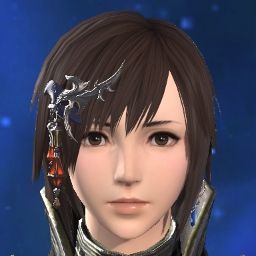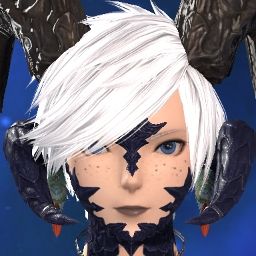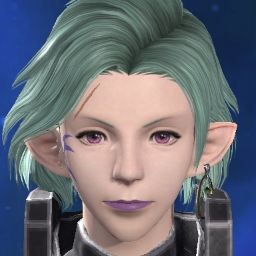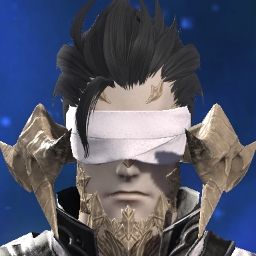-
09-15-2022 10:18 PM #211Player

- Join Date
- Nov 2017
- Posts
- 14,044
- Character
- Aurelie Moonsong
- World
- Bismarck
- Main Class
- Summoner Lv 90
(11)
-
09-15-2022 11:18 PM #212
Sorry, I know I was a bit slow in my reply. It turns out my brain was only capable of producing a series of whistles and clicks until I fell asleep for approximately fifteen hours. It has been known to happen.
The Scions are qualifying clearly in that conversation that they're working on assumptions and speculations, because they're operating primarily from context of the Ascians' current behavior, which obviously has no problem doing harm to other human beings in the name of their mission. They don't know for certain what Hythlo's words mean in the present - the Scions are also clearly speaking purely in context of the Ascians in the present ("their plan doesn't stop with just the Rejoinings...") until Emet-Selch confirms his intentions directly later on in Amaurot. And even then, their initial speculation involves the additional assumption that the Ascians would be able to make distinctions, logistically and specifically, of who and what would be sacrificed and what wouldn't.
I know you have asked in the past: "so, were the Ascians then planning on sacrificing the sapient beings of the Source out of spite?" And I actually have little problem saying that yes, probably, in largely part. Emet-Selch is lashing out and saying and doing a lot of things out of raw spite and resentment in that sequence already, and using the Scions' speculation that you've quoted, already put forth that people who would continue to doggedly oppose them and refuse to cooperate with them were on the chopping block in the post-Innocence cutscene.
Overall, this is what I would say/speculate/interpret: I think the most likely situation for the Ancients is, again, the contents of the third sacrifice is forever unknowable because the plan didn't proceed far enough for them to even come into existence. The Ancients were not able to "nurture the planet until it was bursting with vitality" to be able to evaluate what that vitality looked like and refine their plans from there.
Things are different for the Ascians. Enough time has passed that the "bursting with vitality" stage has been reached, for better or worse. And the Ascians have reached a point psychologically where, yeah, they don't care anymore, anything that doesn't suit them or they suspect would continue to oppose them is getting fed to Zodiark because screw you. I would interpret, actually, the distinction being made that the Ascians can be selective about who and what gets sacrificed - to the extent of judging a potential sacrifice based on "do you hate Zodiark and the Ascians y/n" - makes it harder to believe the initial plan, free of twelve thousand years of malice, would have revolved around unilaterally throwing waves of babies into the grinding machine.(7)Last edited by Brinne; 09-15-2022 at 11:45 PM.
-
09-15-2022 11:37 PM #213
I always took it that the pro-Zodiark crowd was about to perform the sacrifice which is what ended up spurring Hydaelyn's summoning in the first place... or at least the post-Elpis cutscene seemed to be suggesting that.
The notion of him getting pre-empted before they even tried to make him do anything would just sour my opinion of the latter crowd further.(1)
-
09-15-2022 11:43 PM #214
Yeah its nice that at least some of those tags are gone. Also if you hover with your mouse over the tag you can see who wrote it. Tells you a lot about some people.
Emet is also one of those that left poor Mitron behind to suffer for a huge amount of time. And that was a fellow ascian...of course since they are sundered too it seems that they are also quite bellow them.(4)Last edited by Alleo; 09-15-2022 at 11:46 PM.
-
09-15-2022 11:48 PM #215
Well, we already knew that the timeline and depiction of events as portrayed in that cutscene is extremely weird and heavily abstracted to more reflect on Venat's perception of things. Portraying the arguments for the third sacrifice as happening while the Final Days were still going on, for instance, lol.
(6)
-
09-16-2022 12:31 AM #216
But we are not historians, trying to piece together the truth of what really happened based on the evidence in front of us. If we were, this level of skepticism would be justified. We are analyzing a piece of literature, and when presented with a factual ambiguity like that, it's important to look at the story from a thematic and metaphorical level too.
Two of the big themes of FFXIV has always been, one, that it is understandable, but wrong to value your own kind over others, and two, it is important to place faith and hope in the future, and not cling to the ways of the past.
The choice between the third sacrifice and the sundering represents the ultimate expression of that conflict, with Venat being the ultimate expression of the "light" aspect. 'I value people outside my own ingroup that will sacrifice my own people for thier sake, I trust and value the future so much that I am willing to erase the past for the sake of the future.'
Many of the characters involved talk about the targets of the third sacrifice being capable of inheriting the will of the star, becoming stewards like the ancients were, or just being allowed to decide thier own future. Rhetoric that resonates if they are indeed people, will the potential to have a future. Which is why on a thematic level, it makes the most sense for them to be some form of people.
If the targets of the third sacrifice were instead trees and livestock, what would that mean on a thematic level? Suddenly one of the central conflicts is stripped of any weight, and Venat looks like a rabid enviromentalist - which would be fine, if the theme of nature versus technology has ever been a central plank of the conflict between Zodiark and Hydaelyn, but that really is not the case.(11)
-
09-16-2022 01:06 AM #217
Just a quick reply, because Dipping Energy Levels again: this is speaking back to the old misperception that Venat was acting "on behalf" of the sacrifices, in order to protect them in some way, when she never was. This is not actually a matter of "my kind versus another's kind" to her. That never comes up in her motivations after she is introduced properly as a character, is never named as a motivation versus other things, is undermined by the fact that everything was destroyed in the Sundering, and her speech just before the Sundering makes clear that from her perspective, she was cutting down her people for the sake of her people, according to her values. She is keeping them from walking down the wrong path, pre-emptively, in her eyes. She is a person who is taking the step of putting down a beloved family member (in tears) because she is convinced they will go on to lead a destructive lifestyle where they can't be happy.
Venat is not a crazy environmentalist acting on behalf of trees and livestock. To Venat, it is simply irrelevant whether or not the sacrifices were people, or trees or livestock, because her primary concern is her people becoming "stagnant" and "not growing" through any possible means of "clinging to the past." Because what she is afraid of is the future of the Plenty.
Going back to the logistical side of things - and ideas that are more actively speculative on my part - Hythlodaeus's speech suggests to me that the initial life that reappeared after the second sacrifice was, on some level, kind of primordial. "Tiny lives sprouting." Ancients generally have no control over souls and what becomes recognized as authentic life, but the Ancients do have the capacity to shape and guide life force into vehicles that may be more likely to gain those things, based on patterns and research - do you use your creation magicks to form an elemental sprite, or a goobbue, or something like Meteion?
In that sense, even without there being already-existing people, the debate over "do we use the new life to restore our brethren, or to pave the path to a future potentially without us" still makes sense. The second sacrifice provided the star back with the spark and energy for life, and now the Ancients are in the position of deciding how they will raise that life - on a path to evolve to basically livestock, or a path to become sapient beings. Because once again, Venat is a character whose motivations are rooted in ideology, not materialism. She would be arguing for a future where saving their people trapped in Zodiark is sub-optimal versus preparing and nurturing the form of a future generation that could inherit the star from them altogether, because she values the process of "passing on one's legacy to the future" as a self-justifying and morally correct principle.
That ended up less truncated than I intended. Oops.(7)Last edited by Brinne; 09-16-2022 at 01:22 AM.
-
09-16-2022 01:14 AM #218Player

- Join Date
- Aug 2019
- Posts
- 334
- Character
- Floria Aerinus
- World
- Balmung
- Main Class
- White Mage Lv 80
The issue is that the way the themes have been applied to the Sundering narrative since it was introduced in 5.0 hasn't really been consistent, though.
Like, I would have agreed with you back in the days of Shadowbringers, when the emphasis of the conflict was heavily on how the Ancients 'ought' to have stepped aside and let the new life thrive. (Though I can only recall one actual instance of the third sacrifice being framed as the successors to the Ancients as stewards, which is during the conversation with Hythlo in Amaurot - what else were you thinking of?) Back then, everyone kind of took it as a given that the third sacrifice was the player races. That made the story line up very nicely. The Amaurotines wanted to wipe 'us' out 12,000 years ago to bring their people back, but Hydaelyn stood in opposition to them, which led to us inheriting the world. However, Emet and the Ascians still want the same thing in the present: To kill us and save their own people and bring back their civilization as it was. Nice and clean, right?
...but in Endwalker, the framing shifted towards the player races being descendants of the Sundered Ancients instead, which was ultimately confirmed explicitly in an interview. So now everything is muddled. There's no obvious conclusion to draw about what the third sacrifice was, and despite what Hydaelyn's efforts, whatever they were didn't end up inheriting the star after all - we did. Or rather the Ancients kept it, just Sundered.
This makes the message very muddled. My guess is that the original intent in Shadowbringers was that the player races were the new life, but they decided to change that in Endwalker to fit with the narrative about the Sundering's purpose being to force humanity to understand grief and loss. It's no longer a tale of people resisting passing the torch, but a tale of people refusing to accept loss and change and having it forced upon them, then collectively overcoming far in the future. In Shadowbringers Hydaelyn fights Zodiark to save the new life from her people, while in Endwalker Hydaelyn fights Zodiark to 'save her people from themselves'.
But this change left the identity of the third sacrifice blank - a hole in the story. Which the developers decided to address by, well, just not talking about them.
It's hard to really make a good-faith judgement about writer intent when it feels overwhelming like the writer intent isn't even completely consistent behind the scenes.(10)Last edited by Lurina; 09-16-2022 at 01:31 AM.
-
09-16-2022 01:15 AM #219Player

- Join Date
- Mar 2019
- Location
- Gridania
- Posts
- 475
- Character
- Denishia Squirrel
- World
- Brynhildr
- Main Class
- Fisher Lv 100
Which does tie back to Hermes and what he was grappling with: did the Ancients have the right to dictate life into forms that their society approved of, and how did this presumption tie into what was expected of themselves?
(4)
-
09-16-2022 01:52 AM #220Player

- Join Date
- Jul 2015
- Location
- Amaurot
- Posts
- 4,449
- Character
- Tristain Archambeau
- World
- Cerberus
- Main Class
- Black Mage Lv 90
There is an almost stubborn refusal to acknowledge what her motives, as now clearly articulated in the short story (and the Q&A), actually are.
Personally, I can't see how people can place any reliance on what the Ascians planned to do with the final stage of the Rejoining as an indication of what was involved way back then. The Sundering is a massive shift in circumstances, and we know they intend to wipe the slate clean to restore their people, with the specifics of how it'd play out, vague. The only constant is that there will be a sacrifice of life to that end. Nowhere is it implied that it necessarily must be actually sapient life and, more specifically, ancient life.
As per this translation previously posted by Lurina, given that it is Zodiark seeding the star with life (which we know from Elpis would involve the propagation of creations suited to receiving a soul), it would not surprise me in the least if the primal is what was spawning templated creations (namely, animal and plant life, and similar) using stored up concepts, which would then reproduce in the usual way. I agree with your take on how this may have played out, i.e. her faction presenting these entities as being potentially apt to develop sapience if guided through the right evolutionary course, maybe drawing on her encounter with the WoL to add further contours to this narrative. Alternatively, a narrative of make do with those survivors and let the wilderness be populated by the new life as it reclaims it. Her faction's main goal is to get her people to stop the third sacrifice out of the fear that restoration of their civilisation would result in their stagnation, or worse (and of course, her own direct fear is the Plenty and Meteion.) Using such a narrative to stall and buy time until she was ready to summon Hydaelyn is the most logical way of parsing the event to me. My take on it is her answer is to preserve the timeline as is required and provide her followers an adequately persuasive narrative to stall towards that end.(5)Last edited by Lauront; 09-16-2022 at 03:00 AM.
When the game's story becomes self-aware:






 Reply With Quote
Reply With Quote












